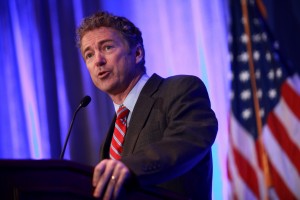
At CPAC earlier this year, Rand Paul promised to deliver “the largest tax cut in American history,” which will “cut everyone’s taxes, from the richest to the poorest,” and “balance the budget in five years.” At the announcement of his presidential candidacy, there was no mention of a tax plan – I thought he might have forgotten to mention it. But this week, he laid his tax reform plan on the table … and it fully lives up to expectations.
There is one overriding criterion which a tax plan proposed by a Republican candidate for president must satisfy in order for it to be politically advantageous: it must credibly promise to deliver economic growth. Senator Paul gets this: writing in The Wall Street Journal, he said, “most important, a smart tax system must turbocharge the economy and pull America out of the slow-growth rut of the past decade.We are already at least $2 trillion behind where we should be with a normal recovery; the growth gap widens every month.”
His opponents who have thus far ventured into tax policy seemingly do not get the point. Chris Christie’s plan is revenue neutral, so that pretty much negates any stimulative effect. Huckabee’s national sales tax is sold on the elimination of the IRS (so who’s going to collect the taxes?) rather than on growth. Rubio’s tax plan (Lee-Rubio) will raise personal income taxes for some and cut it for others, but its elimination of capital gains and corporate taxes renders it politically unsalable (in fact, The Wall Street Journal this week editorialized against Lee-Rubio for its lack of economic stimulation). Bush, Cruz, and Walker have so far been silent on taxes.
The Paul Plan creates a single tax rate of 14.5 percent, applicable to all income, whether derived from wages, unincorporated business income or corporate income (exempting the first $50,000 for a family of four). And unlike his competitors, Paul sells the plan on its growth effect: “the plan is an economic steroid injection. Because the Fair and Flat Tax [his name for the plan] rewards work, saving, investment and small business creation [echoes of Jack Kemp], the Tax Foundation estimates that in 10 years it will increase gross domestic product by about 10%, and create at least 1.4 million new jobs.” Written with help from Steve Forbes (former presidential candidate), Stephen Moore (Heritage Foundation), and Arthur Laffer (of the eponymous curve), the plan has an excellent pedigree.
There is a second if often overlooked criterion of political viability for tax reform plans, and that is justice. Justice requires that income from labor and income from capital be taxed at similar if not identical rates. I am fond of quoting the extraordinary article by John Mueller and Lewis Lehrman in The Weekly Standard observing that “once the GOP shifted its ideal from taxing labor and property income equally to shifting the burden of government onto labor income, the party’s presidential candidates lost the support of independent voters and Reagan Democrats.”
The Paul Plan satisfies this criterion by having that single rate on wages, business income and capital gains. And it does something else: it eliminates one of the bigger affronts to justice in the tax code, the non-deductibility of FICA taxes. The Paul Plan accomplishes this by simply eliminating the FICA tax, funding Social Security and Medicare by dedicating business taxes to this purpose. That has profound implications going forward – and may prove to be a political liability – as it severs the individual contribution from the stream of payments which have come to be seen as “owed.” On the other hand, Social Security and Medicaid are not financially viable in the long run.
The Paul Plan will not satisfy those who think the double taxation of dividends is the biggest injustice in the tax code, but neither does it artificially incentivize corporations to pay dividends over retaining earnings (or vice versa). Similarly, by treating capital gains the same as ordinary income, it meets the Mueller/Lehrman test (expect The Wall Street Journal to grouse about the double taxation of capital gains).
There is one point in urgent need of clarification. In writing about the corporate tax, Paul says, “I would also apply this uniform 14.5% business-activity tax on all companies. … This tax would be levied on revenues minus allowable expenses, such as the purchase of parts, computers and office equipment.” Does he mean to say that payroll expenses will not be deductible? If he does, most corporations will experience a substantial tax increase, even at the lower rate.
While I personally could do without the imprudent-sounding “blow up the tax code” rhetoric, the Paul Plan is nonetheless the boldest, most substantive contribution to the economic policy debate to date. The gauntlet has been thrown down; I am eagerly awaiting to see who will pick it up.
Steve Wagner is the founder and president of QEV Analytics, a Washington DC-based public opinion research firm.


